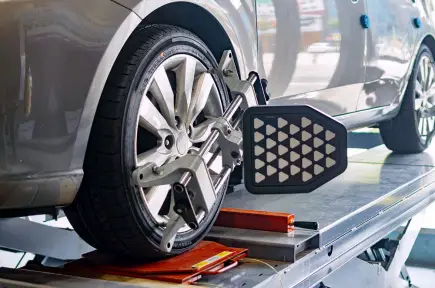
Wheel alignment or tire alignment is one of the most important maintenance items in a car. It doesn't only concern tires or wheels, but it is about the whole suspension system. This includes:
- Tires
- Air pressure
- Springs
- Shock absorbers
- Steering linkages
All these parts come together to provide you with a safe, controlled, and comfortable driving experience. If any of these components doesn't work properly then your experience sure gets compromised.
As we have established what is wheel alignment, let's move to the instances which guide you when should you get your wheels aligned.
How to Know if Your Vehicle Being Out of Alignment
Bad routes, rough terrains, potholes, accidents, all such stuff are harmful to your suspension system. And they can result in a bad alignment. If you experience of these, you better don't waste time.
- Vehicle pulls to one side
- Unusual behavior of a steering wheel
- Tires rapidly or unevenly wear out
- Steering wheel not in the center during the straight drive
What Happens During a Wheel Realignment?
Realignment is a process that brings your suspension system to its default settings.
Technicians use specialized computers to locate the discrepancy in the suspension system/steering linkage. And fix it through a very intricate procedure using bots.
The machines also adjust tire angles to ensure the road contact is optimum. And this aids in the proper realignment.
The Benefits of Proper Alignment
One benefit of proper alignment might be the elimination of the problem that prompted wheel alignment. But it also has other advantages as well which may include:
- Safety (makes a safe and secure drive without the fear of pulling/drifting)
- Improved mileage (aligned tires makes the engine take less effort which results in better mileage)
- Increased tire life (less tire wear resultant in increased tire life)
Maintaining Proper Alignment
Poor alignment is pretty common with excessive use. But it can be avoided in a number of ways. These ways improve your alignment and also increase the time span between two consequent alignments. These are:
- Potholes: You must avoid hitting potholes and curbs because these can really be a deal-breaker. Rough terrains and roads can surely have bumps which can be challenging to your alignment.
- Excess Weight: If you want your alignment to last longer then you must avoid loading heavyweights in your trunk. Your car's chassis would shift below the optimum point from one end due to heaviness. This also prompts a disrupted wheel alignment.
- Conservative Driving: Avoid rash driving. Make it hassle-free. Don't rush, and do not overspeed. Be cool, calm, composed, and compassionate towards your vehicle. This attitude would release a lot of stress from your tires, and anything which is stress-free lasts longer.
These are some of the tips to prolong the time between two alignments. With this, it can be hoped that you'd know what wheel alignment is, and why is it necessary. You must remember that wheel alignment is a must if you want to extend the life and improve the safety of your vehicle.
Same articles

Understanding Vehicle Inspection and Verification Services: Why They Matter for Every Driver
GuidesVehicle inspection and verification services are an essential but often overlooked part of keeping roads safe and cars legally compliant. Most people only think about inspections when it’s...
KLIFEX Brand Overview: High-Quality Automotive Repair Kits for Affordable Repairs
GuidesThe automotive aftermarket has long needed solutions that combine reliability, durability, and affordability. Many car enthusiasts and services are looking for a way...
Fast, Reliable Vehicle Emissions & Inspection Services Made Simple
GuidesFast, reliable emissions and inspection services are essential for keeping vehicles road-ready, compliant with environmental regulations, and safe for daily driving. If you’re looking for quick...

